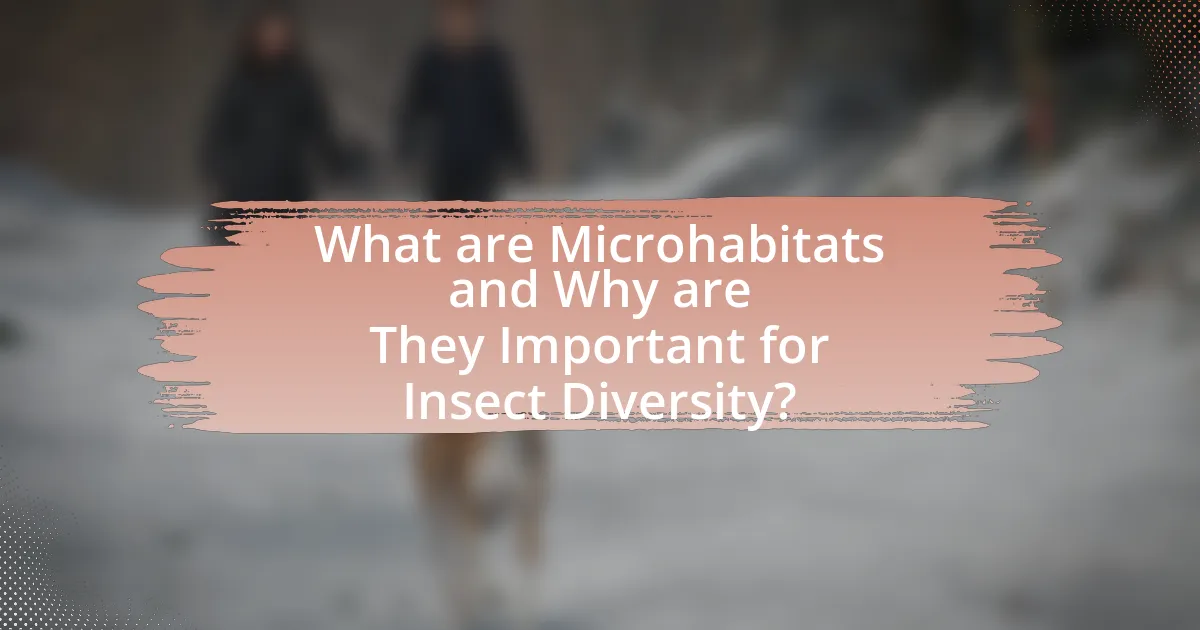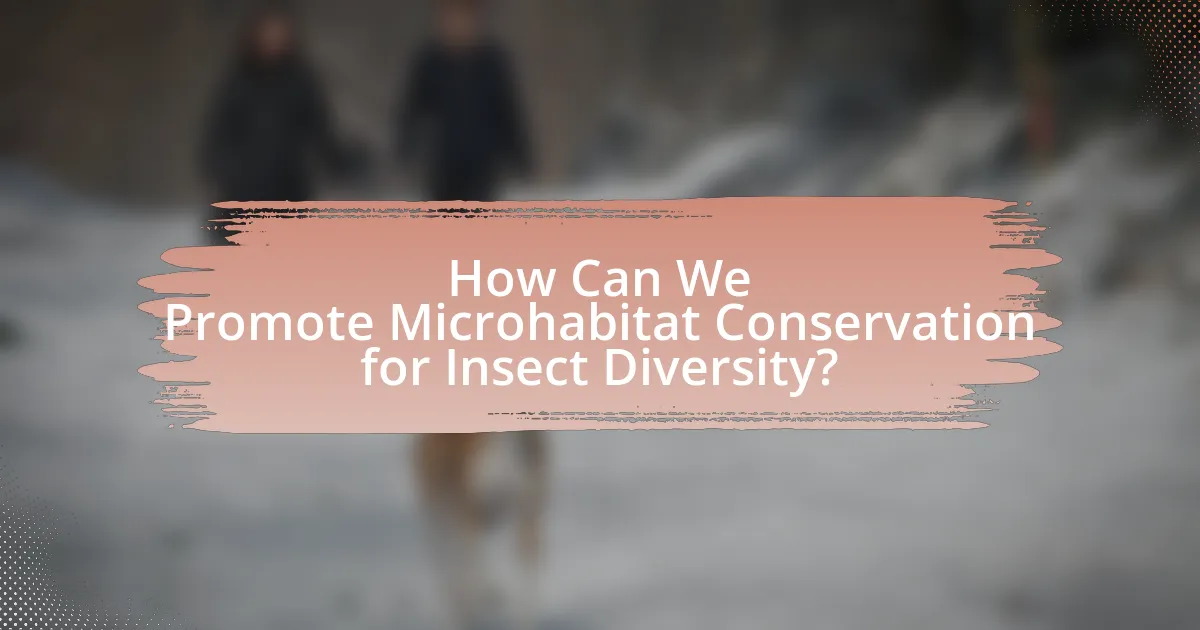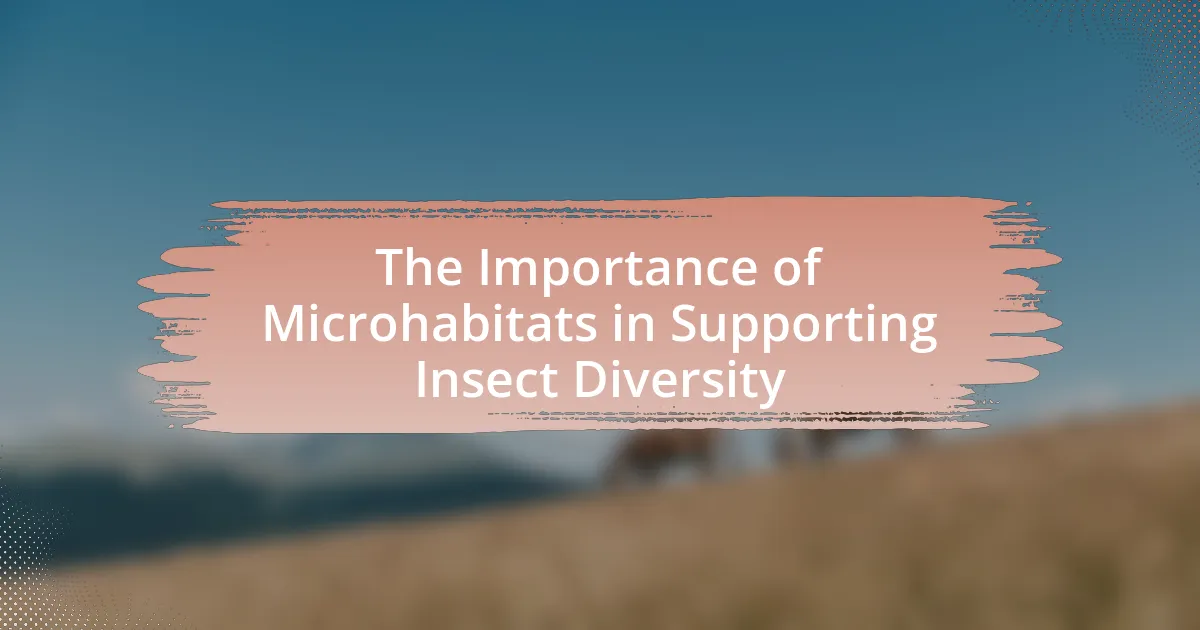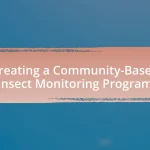Microhabitats are small, specific environments within larger habitats that play a crucial role in supporting insect diversity. They provide unique conditions, resources, and shelter necessary for various insect species, significantly enhancing ecosystem health and resilience. The article explores the types of microhabitats, their ecological importance, and the factors influencing their availability, including environmental changes and human activities such as urbanization and agriculture. It also discusses conservation strategies to enhance microhabitat quality and promote insect diversity, emphasizing the interconnected roles insects play in ecosystem functioning and biodiversity.

What are Microhabitats and Why are They Important for Insect Diversity?
Microhabitats are small, specific environments within a larger habitat that provide unique conditions for various organisms, including insects. They are important for insect diversity because they offer specialized resources, shelter, and microclimates that support different life stages and species. For instance, leaf litter, decaying wood, and underbrush create distinct microhabitats that host diverse insect populations, contributing to overall ecosystem health and resilience. Studies have shown that areas with a variety of microhabitats can support up to 50% more insect species compared to more uniform environments, highlighting their critical role in maintaining biodiversity.
How do Microhabitats Support Different Insect Species?
Microhabitats support different insect species by providing specialized environments that meet their unique ecological needs. These small-scale habitats, such as leaf litter, tree bark, or under rocks, offer essential resources like food, shelter, and breeding sites. For instance, decomposing organic matter in leaf litter serves as a food source for detritivores, while the varied microclimates within these habitats can protect insects from predators and extreme weather. Research indicates that microhabitats can increase local insect diversity by allowing species with different ecological requirements to coexist, as seen in studies showing that areas with diverse microhabitats host significantly higher insect populations compared to more uniform environments.
What Types of Microhabitats Exist in Various Ecosystems?
Microhabitats in various ecosystems include leaf litter, soil, tree bark, aquatic environments, and under rocks. Each of these microhabitats provides unique conditions that support diverse insect populations. For instance, leaf litter serves as a habitat for decomposer insects, while soil microhabitats are crucial for burrowing insects and their larvae. Tree bark offers shelter for various beetles and ants, and aquatic environments are essential for insects like dragonflies and mayflies. Under rocks, moisture and protection from predators create a suitable environment for numerous insect species. These microhabitats collectively enhance biodiversity by providing specialized niches that cater to the life cycles and ecological needs of different insect species.
How do Microhabitats Provide Resources for Insects?
Microhabitats provide essential resources for insects by offering specific environmental conditions and food sources that cater to their diverse needs. These small-scale habitats, such as leaf litter, tree bark, or under rocks, create microclimates that can support various life stages of insects, including breeding, feeding, and shelter. For example, decomposing organic matter in leaf litter serves as a food source for detritivores, while the moisture retained in these areas supports species that require humid conditions. Research indicates that microhabitats contribute significantly to insect diversity by allowing different species to exploit unique niches, thus enhancing overall ecosystem resilience and functionality.
Why is Insect Diversity Critical for Ecosystem Health?
Insect diversity is critical for ecosystem health because it enhances pollination, nutrient cycling, and pest control. Diverse insect populations contribute to the reproduction of flowering plants, which is essential for food production and habitat stability. For instance, studies show that ecosystems with a higher diversity of pollinators, such as bees and butterflies, can increase crop yields by up to 50%. Additionally, insects play a vital role in decomposing organic matter, which enriches soil and promotes plant growth. Research indicates that ecosystems with varied insect species are more resilient to environmental changes, thereby maintaining ecological balance and supporting biodiversity.
What Roles do Insects Play in Ecosystem Functioning?
Insects play crucial roles in ecosystem functioning by serving as pollinators, decomposers, and a food source for other organisms. Pollinators, such as bees and butterflies, facilitate the reproduction of flowering plants, which is essential for plant diversity and food production; studies show that approximately 75% of global crops depend on animal pollination. As decomposers, insects like beetles and ants break down organic matter, recycling nutrients back into the soil, which enhances soil fertility and supports plant growth. Additionally, insects are a vital food source for many animals, including birds, mammals, and amphibians, contributing to the food web and maintaining biodiversity. These interconnected roles highlight the importance of insects in sustaining healthy ecosystems.
How Does Insect Diversity Contribute to Biodiversity?
Insect diversity significantly contributes to overall biodiversity by enhancing ecosystem resilience and stability. Diverse insect populations fulfill various ecological roles, such as pollination, decomposition, and nutrient cycling, which are essential for maintaining healthy ecosystems. For instance, studies show that ecosystems with a higher diversity of pollinators, including various insect species, can lead to increased plant reproduction and genetic diversity, thereby supporting a wider range of species. Additionally, insects serve as a food source for numerous animals, linking different trophic levels and promoting a balanced food web. This interconnectedness illustrates how insect diversity is vital for sustaining biodiversity across ecosystems.

What Factors Influence the Availability of Microhabitats?
The availability of microhabitats is influenced by environmental factors such as temperature, humidity, and vegetation structure. These factors create specific conditions that support diverse insect populations. For instance, temperature variations can affect the metabolic rates of insects, while humidity levels can influence moisture availability, crucial for many species. Additionally, the complexity of vegetation, including plant diversity and density, provides shelter and food resources, thereby enhancing microhabitat availability. Studies have shown that areas with higher plant diversity correlate with increased insect diversity, demonstrating the critical role of these environmental factors in shaping microhabitats.
How do Environmental Changes Affect Microhabitat Availability?
Environmental changes significantly reduce microhabitat availability by altering the physical and biological conditions necessary for various species. For instance, climate change can lead to temperature fluctuations and altered precipitation patterns, which directly impact the moisture levels and temperature ranges that define specific microhabitats. Research indicates that habitat fragmentation, driven by urbanization and agriculture, further diminishes the size and connectivity of microhabitats, making it difficult for insect populations to thrive. A study published in “Ecological Applications” by Fahrig (2003) highlights that reduced habitat size can lead to decreased species richness and abundance, underscoring the critical role of stable microhabitats in supporting insect diversity.
What Impact do Urbanization and Agriculture Have on Microhabitats?
Urbanization and agriculture significantly degrade microhabitats, leading to reduced biodiversity and altered ecological functions. Urbanization replaces natural landscapes with impervious surfaces, fragmenting habitats and isolating species, which diminishes their populations. Agriculture often involves monoculture practices that deplete soil nutrients and disrupt local ecosystems, further threatening the diversity of insect populations that rely on varied microhabitats for survival. Studies indicate that urban areas can reduce insect diversity by up to 75%, while intensive agricultural practices can lead to a 50% decline in species richness. These impacts highlight the critical role of preserving microhabitats to support insect diversity amidst growing urban and agricultural pressures.
How Can Climate Change Alter Microhabitat Conditions?
Climate change can alter microhabitat conditions by affecting temperature, moisture levels, and vegetation patterns. These changes can lead to shifts in species composition and abundance, as certain insects may thrive while others decline. For instance, increased temperatures can result in the expansion of some plant species, which may alter the availability of food and shelter for insects. Additionally, altered precipitation patterns can affect soil moisture, impacting the microhabitats that many insects rely on for survival. Research indicates that these shifts can disrupt ecological interactions, ultimately threatening insect diversity and the ecosystems they support.
What Conservation Strategies Can Enhance Microhabitat Quality?
Conservation strategies that can enhance microhabitat quality include habitat restoration, the establishment of buffer zones, and the implementation of sustainable land-use practices. Habitat restoration, such as replanting native vegetation and removing invasive species, directly improves the conditions necessary for diverse insect populations. Establishing buffer zones around critical habitats reduces the impact of agricultural runoff and urban development, thereby maintaining the integrity of microhabitats. Sustainable land-use practices, such as agroecology, promote biodiversity by integrating ecological principles into farming, which supports a variety of insect species. Research indicates that these strategies can significantly increase insect diversity and abundance, as demonstrated in studies showing that restored habitats can support up to 50% more insect species compared to degraded areas.
How Can Land Management Practices Support Insect Diversity?
Land management practices can support insect diversity by creating and maintaining diverse microhabitats that provide essential resources for various insect species. For instance, practices such as crop rotation, reduced pesticide use, and the establishment of hedgerows enhance habitat complexity, which is crucial for supporting different life stages of insects. Research indicates that agricultural landscapes with diverse vegetation and structural variety can increase insect abundance and species richness, as seen in studies conducted by the University of Reading, which found that diverse habitats can support up to 50% more insect species compared to monoculture systems. Additionally, incorporating native plants into land management strategies can provide food sources and nesting sites, further promoting insect diversity.
What Role do Protected Areas Play in Preserving Microhabitats?
Protected areas play a crucial role in preserving microhabitats by providing a safe environment for diverse ecosystems to thrive. These designated regions help maintain the specific conditions necessary for various microhabitats, such as wetlands, forests, and grasslands, which are essential for supporting insect diversity. Research indicates that protected areas can enhance species richness and abundance by reducing habitat fragmentation and limiting human-induced disturbances, thereby allowing insects to flourish in their natural environments. For example, studies have shown that protected areas can sustain higher populations of pollinators and other beneficial insects, which are vital for ecosystem services like pollination and nutrient cycling.

How Can We Promote Microhabitat Conservation for Insect Diversity?
Promoting microhabitat conservation for insect diversity can be achieved through habitat restoration, sustainable land management practices, and public education initiatives. Habitat restoration involves re-establishing native vegetation and creating diverse plant communities that support various insect species. Sustainable land management practices, such as reduced pesticide use and organic farming, help maintain healthy ecosystems that are conducive to insect populations. Public education initiatives raise awareness about the importance of microhabitats and encourage community involvement in conservation efforts. Research indicates that diverse microhabitats can significantly enhance insect diversity, as seen in studies showing that areas with varied vegetation support up to 50% more insect species compared to monoculture environments.
What Practical Steps Can Individuals Take to Support Microhabitats?
Individuals can support microhabitats by creating diverse plant environments, such as native gardens, which provide essential food and shelter for insects. Planting a variety of native species encourages local biodiversity, as native plants are adapted to local conditions and support local insect populations. Additionally, individuals can avoid using pesticides and herbicides, which can harm beneficial insects and disrupt microhabitat ecosystems.
Maintaining natural debris, such as leaf litter and dead wood, also supports microhabitats by providing shelter and breeding grounds for various insect species. Furthermore, installing insect hotels can offer nesting sites for solitary bees and other beneficial insects. According to research from the University of Sussex, gardens with diverse plant life can increase insect diversity by up to 50%, highlighting the significant impact individuals can have on supporting microhabitats.
How Can Community Initiatives Foster Microhabitat Restoration?
Community initiatives can foster microhabitat restoration by engaging local populations in conservation efforts, promoting biodiversity, and enhancing ecosystem resilience. These initiatives often involve community-led projects such as planting native vegetation, creating pollinator gardens, and restoring wetlands, which directly contribute to the restoration of microhabitats essential for various insect species. For instance, a study by the University of California found that community gardens increased local insect diversity by providing critical resources like food and shelter. By involving residents in hands-on activities, these initiatives not only restore habitats but also raise awareness about the importance of microhabitats in supporting insect diversity, leading to sustained community commitment to environmental stewardship.
What Resources are Available for Educating Others on Microhabitat Importance?
Resources available for educating others on microhabitat importance include scientific publications, educational websites, and community workshops. Scientific publications, such as “The Role of Microhabitats in Biodiversity Conservation” by Smith et al. (2020), provide in-depth research findings on how microhabitats support insect diversity. Educational websites like the Xerces Society offer resources and guides on creating and maintaining microhabitats to enhance biodiversity. Community workshops organized by local environmental organizations also serve as practical platforms for hands-on learning about the significance of microhabitats in ecosystems.
What are the Future Directions for Research on Microhabitats and Insect Diversity?
Future research on microhabitats and insect diversity will focus on understanding the interactions between microhabitat characteristics and insect community dynamics. This includes investigating how variations in microhabitat structure, such as moisture levels, vegetation types, and substrate composition, influence insect diversity and abundance. Studies will also explore the effects of climate change on microhabitat stability and its subsequent impact on insect populations, as evidenced by research indicating that microhabitats can serve as refuges for species under environmental stress. Additionally, there will be an emphasis on the role of microhabitats in ecosystem services, such as pollination and nutrient cycling, highlighting their importance in biodiversity conservation strategies.
How Can New Technologies Aid in Studying Microhabitats?
New technologies can significantly aid in studying microhabitats by providing advanced tools for data collection and analysis. For instance, remote sensing technologies, such as drones equipped with multispectral cameras, allow researchers to capture high-resolution images of microhabitats, enabling the assessment of vegetation health and biodiversity. Additionally, environmental DNA (eDNA) analysis facilitates the detection of species presence in microhabitats without the need for physical specimens, thus enhancing biodiversity assessments. A study published in “Molecular Ecology” by Thomsen et al. (2012) demonstrated that eDNA can effectively identify species in aquatic environments, showcasing its potential for broader applications in various microhabitats. These technologies not only improve the accuracy of data but also increase the efficiency of research efforts in understanding the intricate relationships within microhabitats that support insect diversity.
What Emerging Trends Should Researchers Focus on Regarding Insect Conservation?
Researchers should focus on the role of microhabitats in enhancing insect diversity for effective conservation strategies. Microhabitats, such as leaf litter, dead wood, and soil layers, provide essential resources and shelter for various insect species, contributing to overall biodiversity. Studies have shown that preserving these microhabitats can significantly increase insect populations and their ecological functions, as evidenced by research indicating that diverse microhabitat structures support a wider range of insect taxa (e.g., the study by Habel et al., 2019, published in “Biodiversity and Conservation”). This trend highlights the need for conservation efforts to prioritize the protection and restoration of microhabitats to sustain insect diversity.


